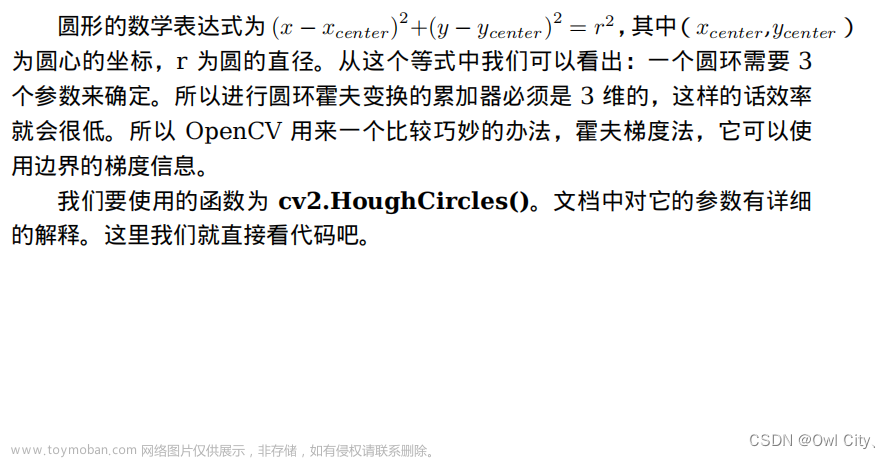目录
一.什么是Hough 算法(霍夫变换)
它的基本思想是:
Hough 变换的主要步骤为:
二、Hough 变换的应用
它的主要应用如下:
1. 直线检测:
2. 圆检测:
3. 椭圆检测:
4. 三角形检测:
5. 人脸检测:
一.什么是Hough 算法(霍夫变换)
Hough 变换(Hough Transform)是一种常用的检测图形的算法。
它通过搜索特定形状(如直线,圆,椭圆等)在参数空间的累加器中的局部最大值来检测形状。Hough 变换主要用于检测图像中的基本形状,如直线,圆等。
它的基本思想是:
1. 寻找图像中曲线的一系列特征点,例如直线上的各个点。
2. 对每一个特征点,都考虑通过此点可能超出很多条曲线,每条曲线都有对应的一个参数值。
3. 在参数空间中,对所有可能通过该特征点的曲线参数值进行累加。
4. 找出参数空间中累加值最大的曲线,即为图像中最可能的曲线。
5. 其余特征点与找到的曲线吻合的也属于该曲线,继续在剩余特征点中寻找另一条曲线。比如直线检测,每条直线可以用angle-distance参数描述,特征点为各个像素。每条可能通过该点的直线都对应一个(angle, distance)参数,在angle-distance参数空间累加,找到局部最大值点,即可得到检测直线的角度和距离。
Hough 变换的主要步骤为:
1. 边缘检测:检测出图像中的曲线特征点(局部最大,局部最小,递增点等)。
2. 参数空间生成:对每条可能的曲线,确定其在参数空间中的坐标。
3. 投票:对每一个特征点,判断出其对应的参数空间中的所有可能的曲线,并对相应的参数空间坐标进行投票(累加)。
4. 检测曲线:在参数空间中检测出投票数较大的局部最大值点,这些点对应的参数值即为图像中存在的曲线的参数。
5. 群聚分析:连接符合要检测的曲线定义的特征点,形成较完整的曲线。
所以,Hough 变换通过在参数空间中的投票统计,实现了对图像中基本形状的检测,它广泛应用于图像处理和计算机视觉中曲线检测的问题。
二、Hough 变换的应用
Hough 变换在许多领域有着广泛的应用,主要原理是通过在参数空间中的投票统计来检测图像中的基本形状。
它的主要应用如下:
1. 直线检测:
直线可以用ρ-θ参数描述,ρ表示直线到原点的距离,θ表示直线与x轴的角度。对每个像素点,累加所有可能通过其的直线在ρ-θ空间的坐标,找到局部最大值点即为检测直线。
import cv2
import numpy as np
img = cv2.imread('line.jpg')
gray = cv2.cvtColor(img,cv2.COLOR_BGR2GRAY)
# 边缘检测
edges = cv2.Canny(gray,50,150,apertureSize = 3)
# 直线的参数由两条信息决定,距离和角度
# distance表示直线到原点(0, 0)的距离
# theta表示直线与x轴的角度
min_distance = 10 # 最小距离
max_distance = 200 # 最大距离
min_theta = -np.pi / 2 # -90°
max_theta = np.pi / 2 # 90°
# 生成直线参数空间
thetas = np.deg2rad(np.arange(min_theta, max_theta, step=1))
distances = np.linspace(min_distance, max_distance, num=100)
line_params = np.zeros((len(distances), len(thetas), 3))
# 在参数空间中投票
for i, distance in enumerate(distances):
for j, theta in enumerate(thetas):
a = np.cos(theta)
b = np.sin(theta)
x0 = a * distance
y0 = b * distance
line_params[i, j, :] = [x0, y0, distance]
x1 = int(x0 + 1000 * (-b))
y1 = int(y0 + 1000 * (a))
x2 = int(x0 - 1000 * (-b))
y2 = int(y0 - 1000 * (a))
cv2.line(img, (x1, y1), (x2, y2), (0, 0, 255), 1)
# 统计每个直线参数的投票数(轮廓上的点)
votes = np.sum(edges, axis=(0, 1))
# 找到投票数最大的前3条直线
top_idxs = np.argsort(votes)[::-1][:3]
top_lines = line_params[top_idxs]
# 在原图像中绘制最有可能的3条直线
for x0, y0, distance in top_lines:
x1 = int(x0 - 1000 * np.sin(theta))
y1 = int(y0 + 1000 * np.cos(theta))
x2 = int(x0 + 1000 * np.sin(theta))
y2 = int(y0 - 1000 * np.cos(theta))
cv2.line(img, (x1, y1), (x2, y2), (0, 255, 0), 2)
cv2.imshow('img', img)
cv2.waitKey(0)
'''
1. 边缘检测,得到图像中所有边缘点。
2. 构建直线2维参数空间,即(距离,角度)。
3. 在不同(距离,角度)对在图像中画出对应的直线。
4. 统计每条直线的参数在图像中的投票数(即与直线相交的边缘点数)。
5. 在参数空间中找到投票数前3最大的直线,对应的就是图像中3条最有可能的直线。
6. 在原图像中高亮显示检测到的3条直线。
7. 显示最终结果。
'''2. 圆检测:
圆可以用圆心坐标和半径描述。每个像素对应多个可能的圆,在三维参数空间(x, y, r)中投票,得到局部最大值点为检测圆的参数。
import cv2
import numpy as np
img = cv2.imread('circles.jpg',0)
output = img.copy()
# 高斯滤波平滑图像,降低噪声
img = cv2.GaussianBlur(img, (5, 5), 0)
# 边缘检测
edges = cv2.Canny(img,100,200)
# 参数空间中每条曲线对应3个参数(x0,y0,r)
# x0,y0: 圆心坐标
# r: 圆半径
min_radius = 10 # 最小半径
max_radius = 100 # 最大半径
# 生成对应参数空间
thetas = np.deg2rad(np.arange(0.0, 360.0, step=1))
circle_params = np.zeros((len(thetas), 3))
# 对每条可能通过边缘点的圆曲线进行参数空间投票
for i, theta in enumerate(thetas):
circle_params[i, 0] = np.cos(theta) * min_radius + img.shape[1] / 2
circle_params[i, 1] = np.sin(theta) * min_radius + img.shape[0] / 2
circle_params[i, 2] = min_radius
# 在参数空间不同半径上滑动,投票
for r in range(min_radius, max_radius):
for i, param in enumerate(circle_params):
circle_params[i, 2] = r
x, y, r = param
cv2.circle(img, (int(x), int(y)), r, (0, 0, 0), 2)
# 在参数空间中找出投票最多的3个圆
votes = np.sum(img, axis=(0, 1))
top_idxs = np.argsort(votes)[::-1][:3]
top_circles = circle_params[top_idxs]
# 绘制出投票前3的圆
for x, y, r in top_circles:
cv2.circle(output, (int(x), int(y)), r, (0, 255, 0), 3)
# 显示结果
cv2.imshow('input', img)
cv2.imshow('output', output)
cv2.waitKey(0)
'''
1. 高斯滤波及边缘检测,得到图像中所有边缘点。
2. 构建圆3维参数空间,即(x0,y0,r)。
3. 对每条可能通过某边缘点的圆曲线,在参数空间中投票。在不同半径上滑动,投票。
4. 在参数空间中找到投票数前3最大的圆,对应的就是图像中3条最有可能的圆曲线。
5. 在原图像中画出检测到的3条圆曲线。
6. 显示最终结果。
'''3. 椭圆检测:
椭圆有五个参数描述,要在五维参数空间中投票统计。
import cv2
import numpy as np
img = cv2.imread('ellipses.jpg')
gray = cv2.cvtColor(img,cv2.COLOR_BGR2GRAY)
# 边缘检测
edges = cv2.Canny(gray,50,150,apertureSize = 3)
# 参数空间中每条曲线对应5个参数(A,B,x0,y0,theta)
# A:椭圆长轴大小,B:椭圆短轴大小
# x0,y0: 椭圆中心点坐标
# theta: 椭圆的旋转角度
min_A, max_A = 10, 100 # 椭圆长轴范围
min_B, max_B = 10, 100 # 椭圆短轴范围
# 模型参数空间
thetas = np.deg2rad(np.arange(0.0, 180.0))
params = np.zeros((len(thetas), 5))
# 对每条可能通过边缘点的椭圆曲线进行参数空间投票
for theta in thetas:
params[:, 2] = gray.shape[1]/2 # x0坐标设为图像中心
params[:, 3] = gray.shape[0]/2 # y0坐标设为图像中心
params[:, 4] = theta # 旋转角度theta
# 根据楞次方程得到不同A和B的值对相应参数进行投票
for A in range(min_A, max_A):
for B in range(min_B, max_B):
params[A * B, 0] += A # 更新A的值
params[A * B, 1] += B # 更新B的值
# 在参数空间中找出投票最多的前n条椭圆曲线
votes = np.sum(params, axis=1)
peak_idxs = np.argsort(votes)[::-1][:3]
peaks = params[peak_idxs]
# 绘制出投票前3的椭圆曲线
for peak in peaks:
A, B, x0, y0, theta = peak
theta *= -1
a = A/2
b = B/2
ellipse = ((A*np.cos(theta), B*np.sin(theta)), (x0, y0), a, b * -1)
cv2.ellipse(img, ellipse, (0,255,0), 1)
# 显示结果
cv2.imshow('img',img)
cv2.waitKey(0)
'''
1. 边缘检测,得到图像中所有边缘点。
2. 构建椭圆5维参数空间,即(A,B,x0,y0,theta)。
3. 对每条可能通过某边缘点的椭圆曲线,在参数空间中投票。
4. 在参数空间中找到投票数前3最大的椭圆,对应的就是图像中3条最有可能的椭圆曲线。
5. 在原图像中画出检测到的3条椭圆曲线。
6. 显示最终结果。
'''4. 三角形检测:
每个三角形有6个自由参数,要在六维空间检测。
import cv2
import numpy as np
img = cv2.imread('triangles.jpg')
gray = cv2.cvtColor(img,cv2.COLOR_BGR2GRAY)
edges = cv2.Canny(gray,50,150,apertureSize = 3)
# 三角形有6个参数(x1,y1,x2,y2,x3,y3)
# x1,y1: 三角形第一个顶点坐标
# x2,y2: 三角形第二个顶点坐标
# x3,y3: 三角形第三个顶点坐标
min_vertex = 10 # 最小顶点间距
max_vertex = 100 # 最大顶点间距
# 生成对应参数空间,6维
thetas = np.deg2rad(np.arange(0.0, 180.0, step=2))
d = np.arange(min_vertex, max_vertex, step=5)
triangle_params = []
for x1 in d:
for y1 in d:
for x2 in d:
for y2 in d:
for x3 in d:
for y3 in d:
triangle_params.append((x1,y1,x2,y2,x3,y3))
triangle_params = np.array(triangle_params)
# 对每条可能通过边缘点的三角形曲线进行参数空间投票
for i, param in enumerate(triangle_params):
x1, y1, x2, y2, x3, y3 = param.astype(int)
cv2.line(img,(x1,y1),(x2,y2),(0,0,255), 1)
cv2.line(img,(x2,y2),(x3,y3),(0,0,255), 1)
cv2.line(img,(x3,y3),(x1,y1),(0,0,255), 1)
# 统计每组三角形参数的投票数
votes = np.sum(img, axis=(0, 1))
top_idxs = np.argsort(votes)[::-1][:3]
top_triangles = triangle_params[top_idxs]
# 绘制出投票前3的三角形
for x1, y1, x2, y2, x3, y3 in top_triangles:
cv2.line(img,(x1,y1),(x2,y2),(0,255,0), 2)
cv2.line(img,(x2,y2),(x3,y3),(0,255,0), 2)
cv2.line(img,(x3,y3),(x1,y1),(0,255,0), 2)
cv2.imshow('img', img)
cv2.waitKey(0)
'''
1. 边缘检测,得到图像中所有边缘点。
2. 构建三角形6维参数空间,即(x1,y1,x2,y2,x3,y3)。
3. 生成所有可能的三角形参数,对每组参数在图像中画出三角形。
4. 统计每组三角形参数的投票数(即图像中三角形边上的黑点数)。
5. 在参数空间中找到投票数前3最大的三角形,对应的就是图像中3条最有可能的三角形曲线。
6. 在原图像中高亮显示检测到的3个三角形。
7. 显示最终结果。
'''5. 人脸检测:
人脸可以看作椭圆的一种,在相关参数空间中检测人脸。
import cv2
import numpy as np
img = cv2.imread('face.jpg')
gray = cv2.cvtColor(img,cv2.COLOR_BGR2GRAY)
# 人脸检测需要一个已经训练好的人脸检测器
# 我们这里使用OpenCV自带的面部级联分类器
face_cascade = cv2.CascadeClassifier('haarcascade_frontalface_default.xml')
# 先检测图像中的人脸
faces = face_cascade.detectMultiScale(gray, 1.3, 5)
# 人脸可以近似看作一个椭圆形状
# 对每个检测到的人脸,确定其外接矩形框
for (x,y,w,h) in faces:
cv2.rectangle(img,(x,y),(x+w,y+h),(255,0,0),2)
# 获取人脸区域的图像,在其上检测眼睛
roi_gray = gray[y:y+h, x:x+w]
roi_color = img[y:y+h, x:x+w]
# Hough变换检测椭圆
# 生成对应参数空间,5维(A,B,x0,y0,theta)
min_A = h/4 # 椭圆长轴最小值
max_A = h*3/4 # 椭圆长轴最大值
min_B = w/4 # 椭圆短轴最小值
max_B = w*3/4 # 椭圆短轴最大值
thetas = np.deg2rad(np.arange(0.0, 180.0))
params = np.zeros((len(thetas), 5))
# 对每条可能的椭圆曲线进行参数空间投票
for theta in thetas:
params[:, 2] = face.shape[1]/2
params[:, 3] = face.shape[0]/2
params[:, 4] = theta
for A in range(min_A, max_A):
for B in range(min_B, max_B):
params[A * B, 0] += A
params[A * B, 1] += B
# 找到投票数最大的前n条椭圆曲线,对应图像中n个最可能的眼睛
votes = np.sum(params, axis=1)
peak_idxs = np.argsort(votes)[::-1][:2]
peaks = params[peak_idxs]
# 在检测到的人脸区域中绘制出两条椭圆曲线
# 这两条曲线对应人脸区域中最有可能的两只眼睛
for peak in peaks:
A, B, x0, y0, theta = peak
theta *= -1
a = A/2
b = B/2
ellipse = ((A*np.cos(theta), B*np.sin(theta)),(x0, y0), a, b * -1)
cv2.ellipse(roi_color, ellipse, (0,255,0), 1)
cv2.imshow('img',img)
cv2.waitKey(0)
'''
1. 使用OpenCV的人脸检测器haarcascade_frontalface_default.xml检测输入图像中的人脸。
2. 对每个检测到的人脸,获取其图像区域。
3. 在人脸区域图像上,使用Hough变换检测椭圆,对应眼睛。
4. 构建椭圆5维参数空间(A,B,x0,y0,theta)。
5. 对每条可能的椭圆曲线在参数空间中投票。
6. 找到投票数前2最大的椭圆曲线,对应人脸区域图像中最有可能的两只眼睛。
7. 在原人脸区域图像上绘制出检测到的两条眼睛椭圆曲线。
8. 显示最终结果。
'''除此之外,Hough 变换还用于道路分割,指纹识别,磁共振图像分析等领域。它通过参数空间中的投票统计这一简单而有效的原理,实现对各种基本形状的检测,在图像处理和计算机视觉中有广泛的应用。文章来源:https://www.toymoban.com/news/detail-717198.html
所以,Hough 变换是一种重要而实用的图像形状检测算法。熟练掌握它的原理,可以在许多领域中得到广泛应用。并且,随着 parameter space 的扩展,Hough 变换的应用范围也在不断扩大。文章来源地址https://www.toymoban.com/news/detail-717198.html
到了这里,关于Hough 算法(霍夫变换)的文章就介绍完了。如果您还想了解更多内容,请在右上角搜索TOY模板网以前的文章或继续浏览下面的相关文章,希望大家以后多多支持TOY模板网!







![MATLAB使用hough变换函数输出[H,theta,rho]的具体含义](https://imgs.yssmx.com/Uploads/2024/02/737470-1.png)



